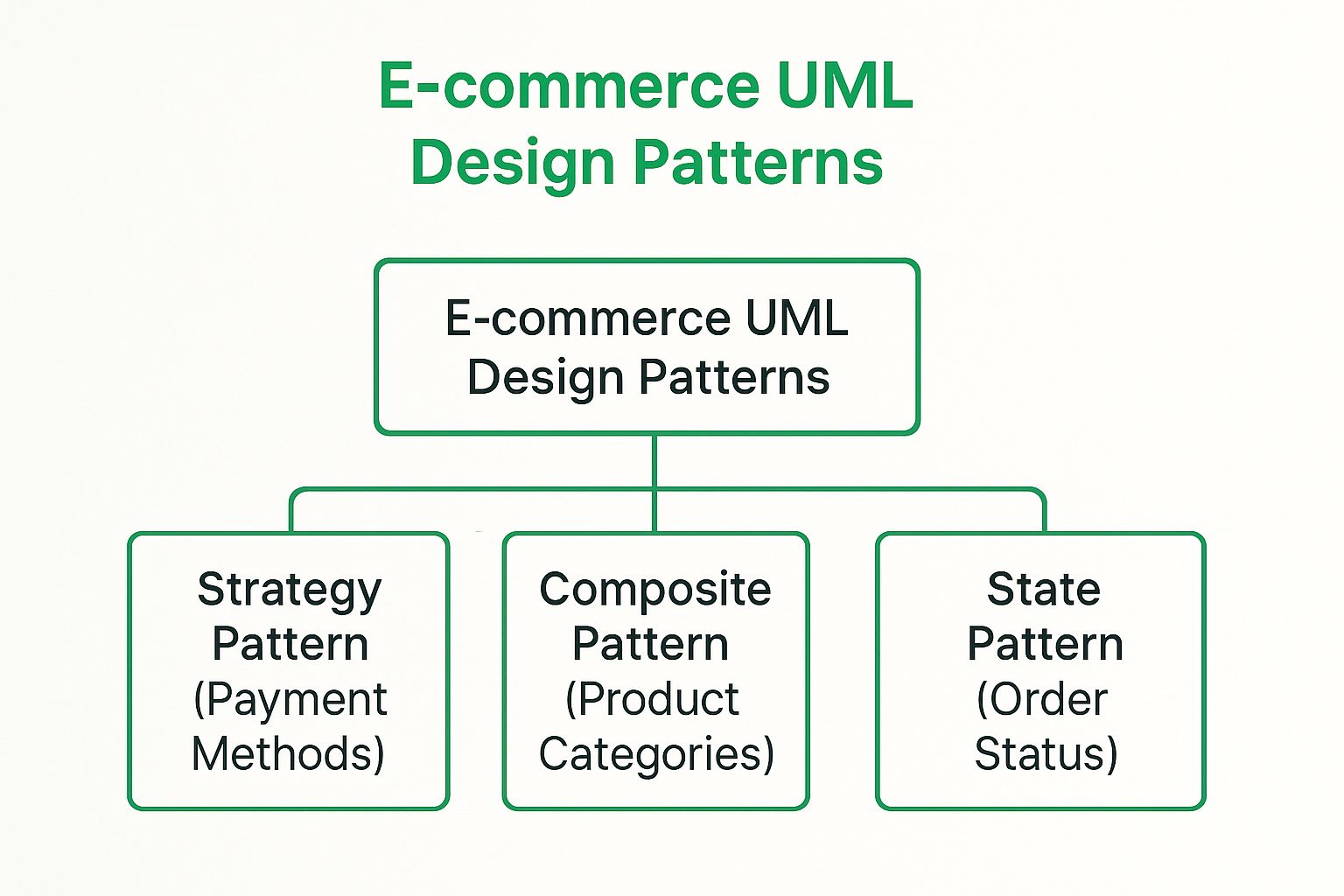Explore 7 practical UML class diagram examples from e-commerce to banking. Gain deep insights and learn how to model complex systems effectively in 2025.
Unlock the power of object-oriented design with these seven detailed UML class diagram examples. Moving beyond abstract theory, this guide dissects the architecture of real-world systems, from e-commerce platforms to hospital management, providing a strategic blueprint for your own software projects. We will break down the essential components, relationships, and design patterns that make these diagrams effective communication and development tools for architects and engineers.
This article is designed to be a practical resource. Whether you are a student mastering the fundamentals or a seasoned developer refining your modeling skills, this list offers actionable insights to help you visualize, communicate, and build robust software systems. We will analyze the structure of each diagram, highlighting key classes, their attributes, and the critical associations that define system behavior.
You will learn how to interpret and apply these models to common development scenarios, enhancing clarity and reducing ambiguity in your projects. We will also explore how modern tools can streamline this entire process, transforming complex codebases into clear, navigable visual diagrams automatically.
Need to create UML diagrams from your existing code? DocuWriter.ai can automatically generate detailed software documentation and diagrams, saving your team valuable time and effort.
A Library Management System UML class diagram is a classic and highly effective example for illustrating core object-oriented programming (OOP) principles. It provides a visual blueprint of a system designed to manage a library’s core functions: cataloging books, handling member accounts, processing loans, and tracking returns. This example is particularly valuable because it models a familiar, real-world domain, making complex concepts like associations, aggregation, and inheritance accessible to both novice and experienced developers.

This example’s strength lies in its clear representation of relationships. It effectively showcases how different entities interact within a system, a fundamental aspect of creating robust software architecture.
The diagram’s core strength is its layered complexity. It begins with fundamental classes such as Book, Member, and Librarian, which are easily understood. It then introduces more complex relationships and structures, providing a practical demonstration of advanced modeling techniques.
Member and a Book through a Loan class shows a direct interaction. This relationship is crucial for tracking which member has borrowed which book.Library class “has-a” collection of Book items. This represents a whole-part relationship where books are part of the library, but can exist independently.Librarian and a Member can both inherit from a parent Person or User class (not explicitly shown in all versions but a common extension). This reduces code duplication by sharing common attributes like name and address.For developers and system architects, this is one of the most practical UML class diagram examples to study. It offers a clear, replicable pattern for modeling systems with distinct entities and transactional relationships.
Member can borrow multiple (*) Book instances, while one Book can be loaned to zero or one (0..1) Member at a time.Book, DVD, Magazine), create an ILibraryItem interface. This promotes a flexible design where different item types can be handled uniformly by the system.This approach is ideal for designing any system that manages inventory and tracks user interactions, from e-commerce platforms to internal asset management tools. It provides a solid foundation for building scalable and maintainable software.
An E-commerce Shopping System UML class diagram models the complex architecture behind online retail platforms like Amazon or Shopify. It provides a blueprint for managing entities such as customers, products, shopping carts, and orders. This example is essential for developers because it demonstrates how to translate intricate business logic and user workflows into a structured, object-oriented design, handling everything from inventory management to payment processing.
The strength of this diagram lies in its ability to model dynamic and stateful processes. It clearly visualizes how objects interact and change state throughout the customer journey, from browsing products to completing a purchase, making it one of the most relevant UML class diagram examples for modern application development.
The diagram’s core strength is its capacity to integrate multiple subsystems into a cohesive whole. It starts with fundamental classes like Customer, Product, and Order and builds upon them to showcase advanced design patterns that solve common e-commerce challenges. This makes it an excellent case study for designing scalable, real-world systems.
Customer and an Order is a direct association, where one customer can have multiple orders. The ShoppingCart class also has a crucial association with both Customer and Product.ShoppingCart is composed of CartItem objects. If the ShoppingCart is deleted, the associated CartItem instances cease to exist, representing a strong ownership relationship.PaymentStrategy interface with concrete implementations like CreditCardPayment and PayPalPayment. The Order class then uses this interface to process payments, allowing new payment methods to be added without changing the Order class.The following infographic illustrates some of the key design patterns often modeled in an e-commerce class diagram.

This hierarchy shows how abstract design patterns can be applied to solve specific, concrete problems within the e-commerce domain.
For architects designing online retail platforms, this UML diagram provides a robust template for structuring complex business logic. It offers a clear path for building a maintainable and extensible system capable of handling high transaction volumes.
Product class or interface. This allows you to handle different product types (e.g., Book, Electronics, Apparel) uniformly while allowing for unique attributes and behaviors.Order lifecycle. This makes the system more robust and easier to maintain, as all logic related to a specific status (like shipping or cancellation) is encapsulated in its own class.This approach is perfect for designing any transactional system, from bespoke retail solutions to large-scale marketplaces, ensuring the architecture is both powerful and flexible.
A Bank Account Management UML class diagram is a powerful example for demonstrating financial system architecture and key object-oriented concepts. It visually maps out the components of a banking system, such as different account types, customer data, transactions, and banking services. This example excels at illustrating inheritance hierarchies and polymorphism, making it invaluable for developers working on fintech applications, online banking platforms, or any system that requires strict business rules and data integrity.

This example is widely used because it models a complex domain with clear, relatable entities. It’s an essential blueprint for building secure, scalable, and compliant financial software.
The diagram’s core strength is its excellent use of inheritance and abstract classes to model a variety of account types. It starts with a base Account class and extends it to specialized classes like SavingsAccount and CheckingAccount, each with unique behaviors and attributes. This structure is a cornerstone of effective financial system design.
SavingsAccount and CheckingAccount inherit common properties like accountNumber and balance from a parent Account class. This promotes code reuse and simplifies system maintenance.withdraw() method in the parent Account class can be implemented differently in each subclass. A CheckingAccount might allow overdrafts, while a SavingsAccount has stricter withdrawal limits, showcasing how a single action can have different forms.Customer class “has-a” collection of Account objects. This represents a strong ownership relationship where accounts cannot exist without a customer.For developers building financial applications, this is one of the most relevant UML class diagram examples available. It provides a robust pattern for managing entities with shared characteristics but distinct behaviors, a common scenario in complex software. Explore these software design principles to build more robust applications.
calculateInterest() in the base Account class to force subclasses to provide their own specific implementations.Customer can have multiple (1..*) Account instances, and each Account is associated with one (1) Customer. This accurately models the business rule.Audit or TransactionHistory class associated with Transaction to log all financial activities. This is crucial for security, debugging, and meeting regulatory compliance requirements.This model is not just for banks; it’s a perfect template for any system managing user accounts with different tiers or features, such as subscription services or e-wallet applications.
A Hospital Management System UML class diagram provides a blueprint for healthcare software, modeling the intricate relationships between patients, staff, appointments, and medical records. It is an excellent example for demonstrating how to design systems in a highly regulated, complex domain like healthcare. This diagram visualizes the core components required to manage patient care, billing, and hospital operations, making it invaluable for developers building Electronic Health Record (EHR) platforms or similar medical information systems.
The value of this example is its ability to model complex, real-world workflows and data privacy requirements. It showcases how to structure a system that handles sensitive information while managing the interactions between diverse user roles, such as doctors, nurses, and administrative staff.
The diagram’s core strength lies in its comprehensive modeling of a multifaceted domain. It connects classes like Patient, Doctor, and Appointment to operational components like Billing and MedicalRecord, illustrating a complete operational cycle. This makes it one of the most robust UML class diagram examples for enterprise-level applications.
Patient and a Doctor through an Appointment class. This relationship is fundamental for scheduling and tracking patient visits.Hospital class can contain collections of Department and Staff objects. This “has-a” relationship shows that departments and staff are part of the hospital but can be managed as distinct entities.Patient class has a MedicalRecord. This is a strong composition relationship, meaning the MedicalRecord cannot exist without the Patient, reflecting data ownership and lifecycle management.For architects designing systems in regulated industries, this example offers a powerful pattern for ensuring security, compliance, and scalability. It provides a clear model for handling complex interactions and data hierarchies.
Doctor, Nurse, Admin) that may inherit from a general Staff class. This pattern facilitates the implementation of role-based access control (RBAC) to protect sensitive patient data.This design is essential for building any system where data integrity, security, and complex workflow management are paramount, such as in finance, legal, or government applications.
A Vehicle Rental System UML class diagram provides a detailed visual model for systems managing transportation services like car rentals or car-sharing platforms. It maps out the key entities and their interactions, covering fleet management, customer reservations, rental agreements, billing, and maintenance. This example is highly valuable for demonstrating how to model resource allocation, state changes, and complex business rules in a service-oriented architecture.
The diagram’s utility comes from its clear depiction of how temporal and transactional data is managed, which is critical in any system where resource availability is time-sensitive. It serves as a blueprint for platforms like Enterprise Rent-A-Car’s management system or car-sharing services such as Zipcar.
The strength of this diagram is its ability to model the lifecycle of a key resource: the vehicle. It illustrates how an object’s state (e.g., available, rented, under maintenance) dictates system behavior and interactions. This provides a practical look at designing dynamic, state-aware systems.
Customer to a Vehicle through a RentalAgreement class. This association captures the specifics of a single rental transaction.Fleet class might be composed of multiple Vehicle objects. This represents a strong ownership relationship where a Vehicle cannot exist outside the context of the company’s Fleet.Car, Truck, Motorcycle) can inherit from a general Vehicle class. This allows the system to handle various vehicle types polymorphically while sharing common attributes like licensePlate and model.This is one of the more dynamic UML class diagram examples, offering a template for any system managing bookable assets. It provides a clear pattern for handling reservations, billing, and resource status tracking.
Available, Rented, UndergoingMaintenance) directly in the Vehicle class. This makes business logic clearer and easier to implement.RentalAgreement or Reservation class is essential. It should hold transaction-specific data like startDate, endDate, totalCost, and pickupLocation, which are attributes of the relationship, not the individual entities.Car, Truck, or Van. This decouples the client code from the specific vehicle classes, making the system more flexible and easier to extend.This design is perfect for building systems in the transportation, equipment rental, or hospitality industries. If you are interested in creating diagrams like these, you can explore options with a powerful UML diagram creator.
A Student Information System (SIS) UML class diagram models the complex network of relationships within an educational institution. It provides a visual architecture for managing student data, course catalogs, enrollments, grading, and faculty assignments. This example is particularly powerful for demonstrating how to handle intricate business rules and many-to-many relationships in a large-scale, data-intensive system, making it an essential study for enterprise-level software design.
The value of this diagram lies in its ability to translate academic policies and operational workflows into a structured, object-oriented model. It serves as a blueprint for systems like Banner ERP or PeopleSoft Campus Solutions, which form the backbone of modern university administration.
The diagram’s core strength is its capacity to model complex, multi-entity interactions that define academic life. It moves beyond simple one-to-one relationships to represent the nuanced connections between students, courses, and faculty, providing a clear map for implementing core institutional logic.
Student and Course is a classic many-to-many scenario. A student can enroll in multiple courses, and a course can have many students. This is elegantly resolved with an association class.Enrollment class is used to manage the many-to-many link. This class holds attributes specific to the relationship, such as grade and enrollmentDate, which do not belong to either Student or Course alone.Department and Faculty can be modeled to show organizational hierarchies. A Department “has-a” collection of Course offerings and Professor members, illustrating aggregation and composition within an academic structure.For architects designing large-scale administrative systems, this is one of the most relevant UML class diagram examples available. It provides a robust template for managing entities with complex life cycles and interdependencies, applicable far beyond the education sector.